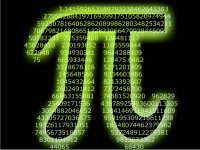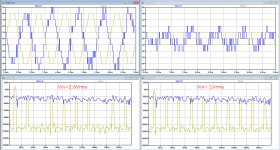Hi Ken,
I've put the Anagram technique in a LTSpice sim, where I constructed Tri dither from two independent square dither sources each having +/-0.5 LSB amplitude, in the diagram Tri+ and Tri-.
Both where offered to DAC's running at 40Khz.
The common mode signals from both Dac's where processed by an op amp to remove the common mode voltage.
In the image below, you see the spectrum of one Dac output in red , versus the spectrum of the opamp's output in blue.
In the lower part you see the same signals in the time domain.
The added noise in the digital domain is indeed effectively removed in the analogue domain, so to me it seems almost as if nothing was added at all.
Hans
.
Cool simulation, Hans.
I don’t suppose that there is a simple way to introduce a little non-linearity within the DACs, for the noise source (dither) to linearize, and then see whether DAC distortion remains reduced after the differential amplifier has subtracted the dither noise?
Ken, if you can specify what kind of nonlinearity you have in mind, It can most likely be implemented.
Hans
Hans
Nevertheless, I do think the experiments are interesting and help to understand more about the topic, like the initiative was aiming to.
It is not controlled scientific experiments but nobody claimed that.
Subjective listening impressions serve 2 purposes, 1, individual amusement, 2, marketing. As long as listeners and reader are aware of those 2 aspects and not confuse it for objective data, then sure, it's not a waste of time.Not reliable? I think, yes and no, regarding that question.
Not reliable for the purpose of utilizing the indicated findings to dictate the set features a person should, or shouldn't absolutely want in their next DAC. For the purpose of encouraging someone to subjectively evaluate certain non-typical DAC implementation features or approaches for themselves, however, I feel that the group findings are helpful. Think of them as more a collection of anecdotal listening evaluations utilizing the same controlled sets of test files. Which, necessarily, were the only experiment system aspects which we had control over.
Ken, if you can specify what kind of nonlinearity you have in mind, It can most likely be implemented.
Hans
I suppose, something where a couple of LSBs generate the incorrect output value? I’m not sure. Whatever is the easiest non-linearity to simulate maybe. Something which produces DAC A.C. signal distortion, and which can be erased by the application dither noise.
The same experience. There is no perceived NOS drop when images are still present (unfiltered). Perhaps Keven talks about NOS drop, as his DAC has 7th order filter on the output. Once filters are deployed, sinc drop must be compensated.Perhaps it is important to add that I never heard the sinc droop through these tests. But I may perceived this as a change in dynamics after all...
To simulate ladder distortions some MSB's must carry incorrect values. Then use sign-magnitude encoding to not see 0 crossover distortions otherwise results would depend on the amplitude, we need a simple model.I suppose, something where a couple of LSBs generate the incorrect output value? I’m not sure. Whatever is the easiest non-linearity to simulate maybe. Something which produces DAC A.C. signal distortion, and which can be erased by the application dither noise.
Last edited:
In an ideal world I would say that when you add someting in the digital domain, in this case dither noise, that is subtracted at a later stage in the analogue domain, the end result should be as if nothing was added in the first place.
Hans
This has been discussed at length here before. Dither modifies the transfer function of the DAC. When you add your +-0.5 LSB random sources together to get simple TPDF you now have points in between so proper truncation and rounding is part of the operation. Once undithered data goes through the DAC the distortion is indistinguishable from signal and no analog process can fix it.
The experiment is very easy to do, take only a few cycles of 1kHz at only a few LSB's amplitude and compare in just about any software's TPDF function. The distortion is gone at any time scale (there is no averaging effect) leaving a pure 1kHz tone and random noise.
Subjective listening impressions serve 2 purposes, 1, individual amusement, 2, marketing. As long as listeners and reader are aware of those 2 aspects and not confuse it for objective data, then sure, it's not a waste of time.
Oh, okay. So, logically, you only purchase your audio products strictly by reading it's specifications sheet. Without even the briefest in-store audition, or having read any subjective opinions on it, or otherwise obtained someone else's subjective assessment, correct? Which, necessarily dictates that your system is based around a mass-market AV receiver, yes? I'm curious as to which one you own.
Plus, here's a secret. A home HiFi system is for the purpose of musical amusement.
This has been discussed at length here before. Dither modifies the transfer function of the DAC. When you add your +-0.5 LSB random sources together to get simple TPDF you now have points in between so proper truncation and rounding is part of the operation. Once undithered data goes through the DAC the distortion is indistinguishable from signal and no analog process can fix it.
The experiment is very easy to do, take only a few cycles of 1kHz at only a few LSB's amplitude and compare in just about any software's TPDF function. The distortion is gone at any time scale (there is no averaging effect) leaving a pure 1kHz tone and random noise.
Thanks, for the information, Scott.
I’ll do the sim tomorrow, but Scott is right.
With a small signal, each Dac will output this signal burried in dither noise.
But the common mode noise will be subtracted later leaving a signal without noise.
Hans
With a small signal, each Dac will output this signal burried in dither noise.
But the common mode noise will be subtracted later leaving a signal without noise.
Hans
Just as an FYI - I believe that Anagram no longer exists. Their IP appeared to have been acquired by an Asian company called, 'abc-pcb' who also no longer appear to exist. The Anagram IP seems to still have carried on though, having been acquired by a Swiss company called, 'engineered electronics'.
Their website is: Engineering your projects - Engineered Electronics
Their website is: Engineering your projects - Engineered Electronics
Last edited:
Other than speakers and room acoustics, audible transparency has been achieved with preamps, DACs, amps, cables and the auditioning have been done decades ago on those and documented all over the place. Not only that, for those audibly transparent replaying components, measurements have been published for consumers to correlate to auditioning results.Oh, okay. So, logically, you only purchase your audio products strictly by reading it's specifications sheet. Without even the briefest in-store audition, or having read any subjective opinions on it, or otherwise obtained someone else's subjective assessment, correct?
Is something audibly wrong with mass-market AV receivers?Which, necessarily dictates that your system is based around a mass-market AV receiver, yes? I'm curious as to which one you own.
And what do you think is the best way to achieve hi-fi, spending more time and money on already matured technology like DAC?Plus, here's a secret. A home HiFi system is for the purpose of musical amusement.
I'm curious as to how your listening spot's frequency response is like.
Actually, there can be reasons other than sound quality to design and/or build your own equipment, for example that you like doing so, or that having something to hyperconcentrate on helps you to calm your nerves, just like memorizing digits of pi does in this song of Kate Bush (temporarily anyway):
Kate Bush - Pi - YouTube
Kate Bush - Pi - YouTube
Thanks, for the information, Scott.
Dither in terms of fixing broad smooth transfer function non-linearity would be a totally different thing, this is not the purpose of dither but rather some kind of auto-cal.
Here's the result of the Anagram simulation with an 1Vrms and a 2.8Vrms signal, mixed with Tri dither. Used step size for the LSB in this sim is 1Volt
What you see is the output of one of the two Dac's in blue and the Anagram result in green after subtracting the common mode dither from both Dac's.
Harmonics do not go down when removing the common mode signal, but the noise drops by almost by 100dB in this case.
Also interesting to see between the two different levels is that the harmonics are staying at the same level, while the main lobe increases proportional to signal input.
The point however is that an LSB, instead of having the 1V step size as used here, has a much lower level like 85uV for a 16 bits Dac with an output of 2Vrms max.
But added to this comes the uncorrelated noise from the several Dac's, the noise from the op-amp removing the common mode signal and the accuracy of the four resistors surrounding the op-amp.
So in a practical situation, the 100dB will be hard to achieve, but for 16 bit Dac's it must be possible to get 40 to 50dB noise reduction with 0.1% resistors which is already significant.
Looking from a different side, I don't know what is to be preferred, a signal just visible above the white noise instead of the many harmonics without noise.
Hans
.
What you see is the output of one of the two Dac's in blue and the Anagram result in green after subtracting the common mode dither from both Dac's.
Harmonics do not go down when removing the common mode signal, but the noise drops by almost by 100dB in this case.
Also interesting to see between the two different levels is that the harmonics are staying at the same level, while the main lobe increases proportional to signal input.
The point however is that an LSB, instead of having the 1V step size as used here, has a much lower level like 85uV for a 16 bits Dac with an output of 2Vrms max.
But added to this comes the uncorrelated noise from the several Dac's, the noise from the op-amp removing the common mode signal and the accuracy of the four resistors surrounding the op-amp.
So in a practical situation, the 100dB will be hard to achieve, but for 16 bit Dac's it must be possible to get 40 to 50dB noise reduction with 0.1% resistors which is already significant.
Looking from a different side, I don't know what is to be preferred, a signal just visible above the white noise instead of the many harmonics without noise.
Hans
.
Attachments
Can you bury harmonics in the noise? Is there any research on that, especially what our ears do with a noisy signal in that regard?
- Home
- Source & Line
- Digital Line Level
- What do you think makes NOS sound different?

